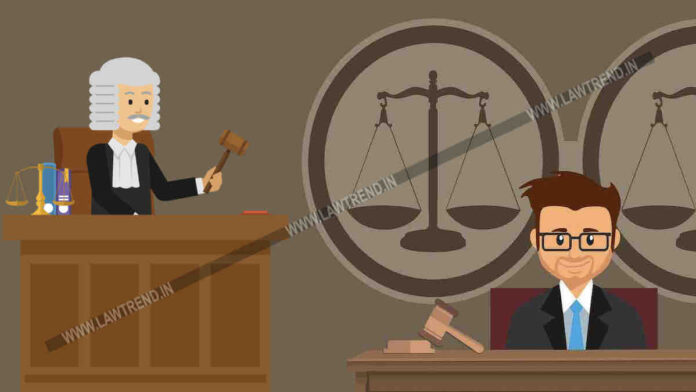In India, the largest democratic country in the world, the judiciary is a part of the constitution. It protects citizens as well as safeguards their rights. It is the final authority where citizens can get justice in legal matters under the constitutional order.
It plays an important role in law enforcement and decision making on disputes between citizens, states and other parties. Be it the Supreme Court or the district level court, they work to maintain law and order in the country.
In this judicial system, the work of dispensing justice at the district level is done by the Judges and Magistrates. Many people consider these two to be the same. However, there is a vast difference between the powers and functions of a Judge and Magistrate.
Chapter II of the Code of Criminal Procedure 1973, deals with the Constitution of Criminal Courts and Officer.
Here we will give you complete information about the functions and rights of both of them.
Classes of Criminal Courts:
Section 6 of CrPC provides that besides the High Courts and the Courts constituted under any law, there shall be, in every State, the following classes of Criminal Courts, namely:
- Courts of Session;
- Judicial Magistrates of the first class and, in any metropolitan area, Metropolitan Magistrates;
- Judicial Magistrates of the second class; and
- Executive Magistrates
Judge and Magistrate Selection Process– Generally
According to the constitution, there is a three-layer court system in the Indian judicial system. Supreme Court, High Court and Lower Court. To become a district judge, you must have a bachelor’s degree in law. Along with this, you must have seven years of experience of practicing law. After which you can sit in the exam.
Judicial Services Examination, District or Subordinate Court Examination is organized by the State Public Service Commission in every state of India. This exam may vary from state to state. The Judge is appointed by the High Court.
At the same time, any student after taking a law degree can become a magistrate by directly passing the PCS-J i.e. Provincial Civil Service (Judicial) exam. Those who become magistrates by giving exams remain Second/First class magistrates for a few years, then they get promoted.
There are two types of cases in court
Before knowing the difference between magistrate and judge, it should be known that broadly there are two types of cases for justice, civil cases and criminal cases. Civil cases are cases in which rights and compensation are sought. There are other criminal cases in which punishment is sought.
Know the difference between a Magistrate and a Judge
There is a difference of rank and authority between a magistrate and a judge. A magistrate cannot impose a sentence of death or imprisonment for life. The level of magistrate also consists of several levels.
The topmost post among them is CJM i.e. Chief Judicial Magistrate (Section 12 CrpC). In metropolitan cities, it is also called Chief Metropolitan Magistrate (Section 17). There is one CJM in a district.
The main function of the District Magistrate (Executive Magistrate) is to oversee the general administration, collect land revenue and maintain law and order in the district. He is the head of the revenue organizations. DM is also responsible for the registration of land, division of cultivated fields, settlement of disputes, bankruptcies, management of jagirs, giving loans to farmers and drought relief.
All other officers of the district were subordinate to him and made available to him every activity of their respective departments. The functions of District Magistrate are also entrusted to them. Being the District Magistrate, he can also inspect the police and the subordinate courts of the district.
The judges are above the CJM. The District Judge and ADJ i.e. Additional District Judge (Section 9 and 10) come in the rank of Judge. At this level, when the judges deal with civil cases, they are called District Judges, but when the same judges deal with criminal cases, they are called Sessions Judges. There is only one judge, who hears both types of cases. The decisions of the District and Sessions Court can be challenged in the High Court.
Hierarchy of Magistrates and Judges
Chief Judicial Magistrate (Section 12 CrPC): This is the highest rank of the magistrate in any district. All judicial magistrates in the district are controlled by the Chief Judicial Magistrate. No Chief Judicial Magistrate can give death penalty and life imprisonment. They cannot give such punishment which extends to imprisonment for a term exceeding 7 years.
Magistrate First Class (Section 11 CrPC): These magistrates give preliminary hearing to any case. Any case initially goes to the Magistrate of the First Class. This court is a very important part of the Indian judiciary. If an accused is convicted in their court, then the Magistrate of the First Class can impose imprisonment of up to three years and a fine of up to ten thousand rupees for the offense. No Magistrate of the first class can impose imprisonment for more than three years and a fine not exceeding ten thousand rupees.
Magistrate Second Class (Section 11 CrPC): From this post begins the order of magistrate in the judiciary. Any matter related to civil comes first in this court. In criminal cases, a Court of a Second Class Magistrate may award imprisonment for a term not exceeding one year and a fine which may extend to Rs 5000, or both of these together to any proven guilty.
Metropolitan Magistrate (Section 16 CrPC): Whereas for metropolitan cities, posts like Metropolitan Magistrate have been kept. Chief Metropolitan Magistrate and Metropolitan Magistrate have been kept in these posts. The Chief Metropolitan Magistrate enjoys all the same powers as the Chief Judicial Magistrate. The Metropolitan Magistrate enjoys all the same powers as a Magistrate of the First Class.
Executive Magistrate (Section 20 CrPC): In addition, the State Government appoints as many Executive Magistrates as it desires in each district and metropolis and appoints one of them as District Magistrate.
Power of Punishment
Sessions Judge (Section 28 CrPC): The Court of Session (Session Court) is presided over by a judge appointed by the High Court. The High Court appoints additional as well as assistant sessions judges. The Sessions Judge or Additional Sessions Judge may pass any sentence authorized by law. But if the death sentence is given, the confirmation of this sentence by the High Court is mandatory.
Additional/Assistant Sessions Judge (Section 28 CrPC): These are appointed by the High Court. They can hear cases relating to murder, theft, dacoity, pick-pocketing and other such matters in the absence of the Sessions Judge. An Assistant Sessions Judge may pass any punishment authorized by law except the death penalty or imprisonment for life or imprisonment for a term exceeding ten years.
Chief Judicial Magistrate (Section 29 CrPC): CJM may pass any sentence authorised by law except a sentence of death or of imprisonment for life or of imprisonment for a term exceeding seven years.
First Class Magistrate (Section 29 CrPC): He may pass a sentence of imprisonment for a term not exceeding three years, or of fine not exceeding ten thousand rupees, or of both.
Second Class Magistrate (Section 29 CrPC): He may pass a sentence of imprisonment for a term not exceeding one year, or of fine not exceeding five thousand rupees, or of both.
Chief Metropolitan Magistrate (Section 29 CrPC): CMM shall have the powers of the Court of a Chief Judicial Magistrate.
Metropolitan Magistrate (Section 29 CrPC): He has the powers of the Court of a Magistrate of the first class




